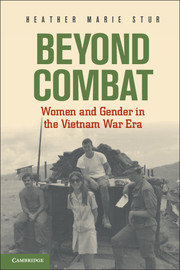Book contents
Introduction
Published online by Cambridge University Press: 05 June 2012
Summary
Lily Lee Adams served as an Army nurse in Vietnam from 1969 to 1970 at the 12th Evacuation Hospital in Cu Chi. She was a twenty-year-old American girl, a New Yorker, the daughter of an Italian mother and a Chinese father. John F. Kennedy's call to young people – “Ask not what your country can do for you, ask what you can do for your country” – had inspired her to join the military. In many ways, Adams's story was typical of young Americans who volunteered for the armed services in the 1960s, but her Asian heritage resulted in some telling differences. Some of the U.S. servicemen she encountered in Vietnam assumed that Adams was a prostitute when she was not wearing her nurse's uniform. “When I was in civilian clothes and walking around with a guy, the other guys would just assume I was a whore,” Adams said. “The Army used to truck in whores all the time.” She learned to keep her military identification with her at all times. “It really hurt inside that I had just spent twelve hours treating their buddies, and they thought I was just some Vietnamese whore,” Adams said. When GIs solicited her for sex, she would think, “You guys don't even know that if you came into my hospital I’d be taking care of you, giving you everything I have just to keep you alive.” Even the Vietnamese guards at the post exchange (PX) where Adams was stationed assumed she was a prostitute and demanded her ID while waving other military staff through. Adams remembered a nurse from the Philippines who left Vietnam after a few months of service because of similar treatment. “She was not used to the sexual harassment and racial discrimination, and she asked me how I handled it,” Adams said. “I told her I got used to it. I grew up with discrimination and learned how to deal with it.”
The troops’ responses to Adams were grounded in a set of contradictory assumptions and images – passed down in basic training, popular culture, political speeches, and GI folklore – that assigned ideologically charged meanings to Asian and American women. Focusing on the tension between these images and the lived experiences of men and women in (and after) Vietnam, Beyond Combat: Women and Gender in the Vietnam War Era investigates the conflict, not just as a military maneuver, but also as a complex web of personal encounters between Americans and Vietnamese that took place in the hothouse environment of war. Although popular memory of the Vietnam War centers on the “combat moment,” refocusing attention onto women and gender paints a more complex – and, ultimately, more accurate – picture of the war's far-reaching impact beyond the battlefields. A substantial majority of interactions between American men and various groups of women, whether American or Vietnamese, took place not in combat situations, but on bases in Long Binh and Qui Nhon, in brothels in An Khe and Cam Ranh Bay, and along the boulevards of cities such as Saigon and Da Nang. These encounters, which were grounded in the reality of American power and dominance even when individual GIs attempted to soften that reality through humanitarian outreach, were shaped by a cluster of intertwined images that Americans used to make sense of and justify intervention and use of force in Vietnam: the girl next door, a wholesome reminder of why the United States was committed to fighting communism; the dragon lady, at once treacherous and mysterious, a metaphor for both Vietnamese women and South Vietnam; the “John Wayne” figure protecting civilization against savagery; and the gentle warrior, whose humanitarian efforts were intended to win the favor of the South Vietnamese. A careful examination of these images reveals the ways in which home-front culture influenced American policymaking and propaganda regarding Vietnam, and how the actual lived experiences of the men and women on the ground both enforced and challenged the gender ideology deployed in military and diplomatic rhetoric.
- Type
- Chapter
- Information
- Beyond CombatWomen and Gender in the Vietnam War Era, pp. 1 - 16Publisher: Cambridge University PressPrint publication year: 2011



